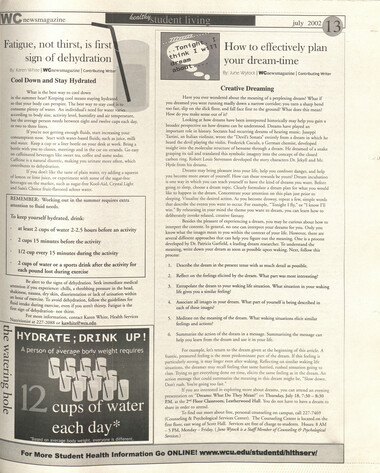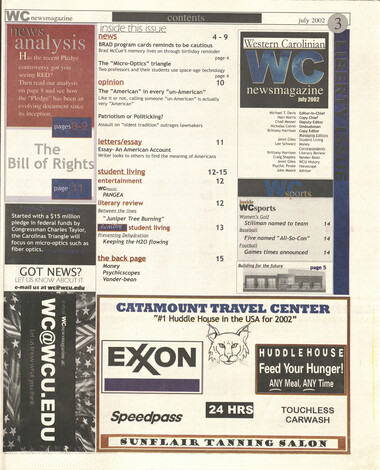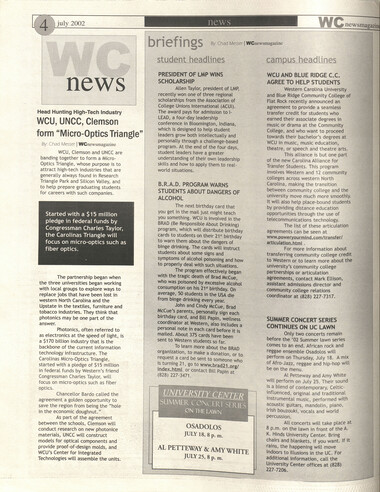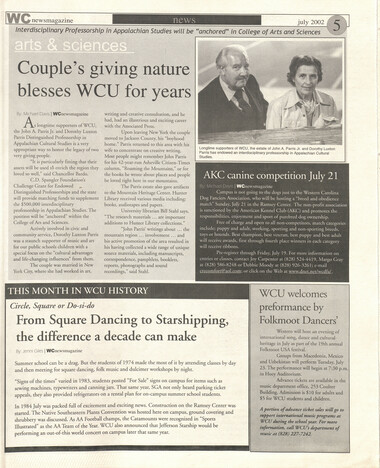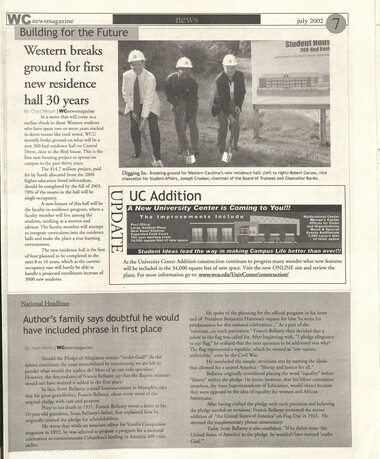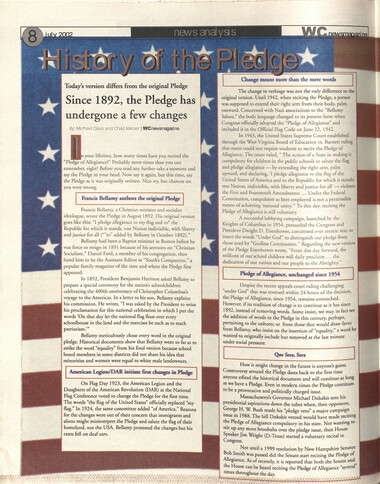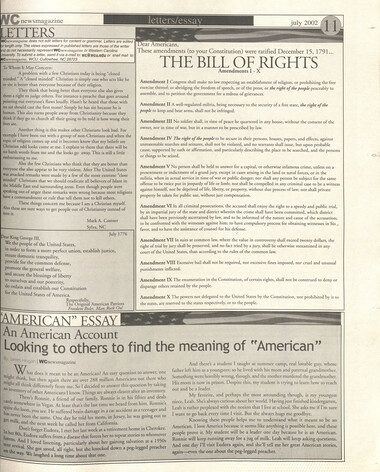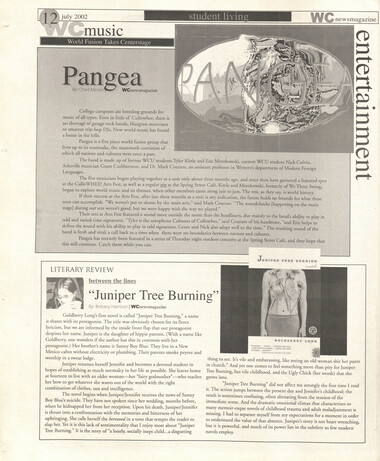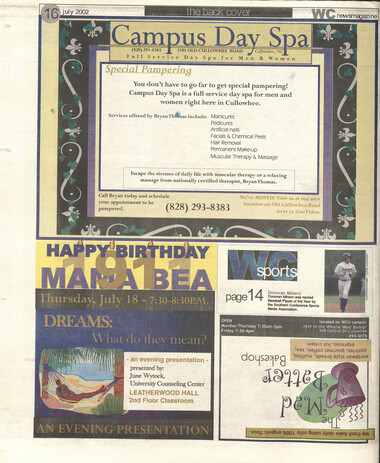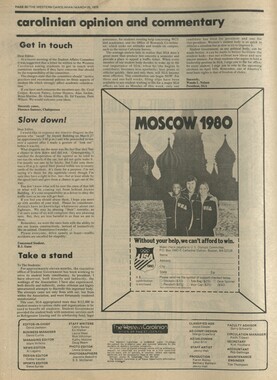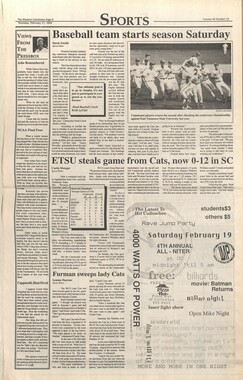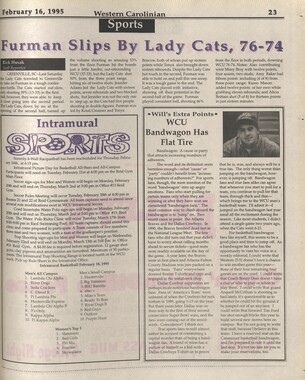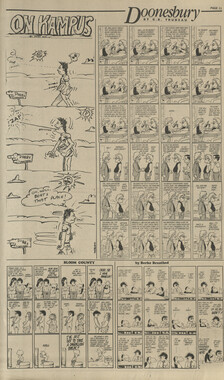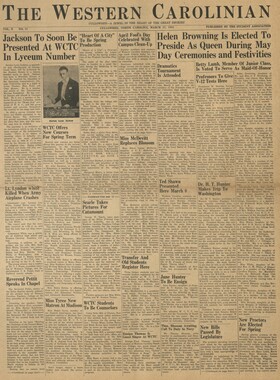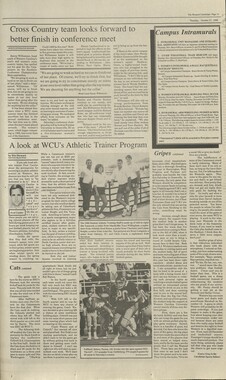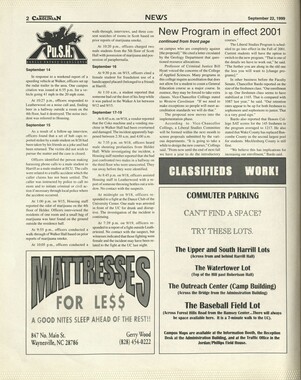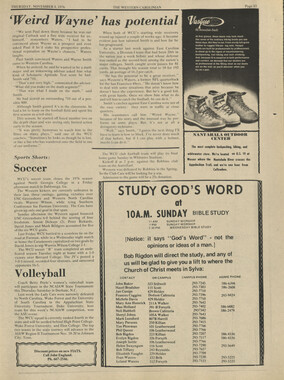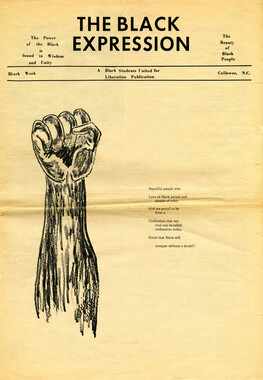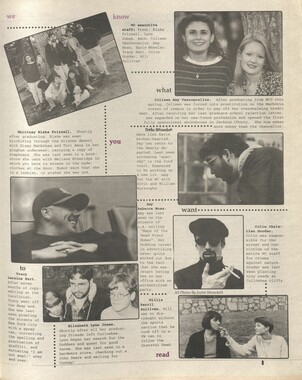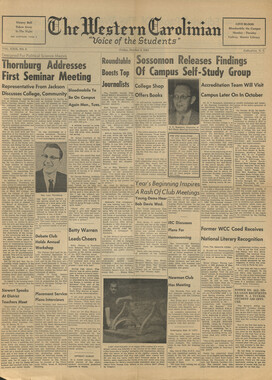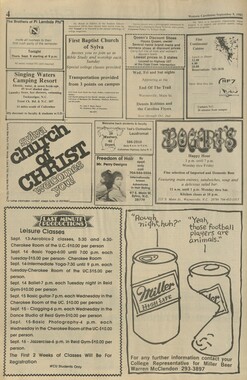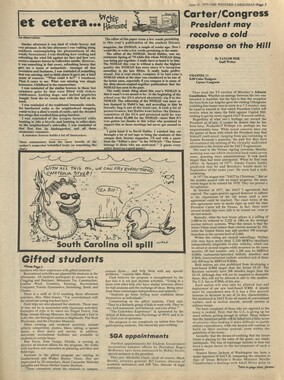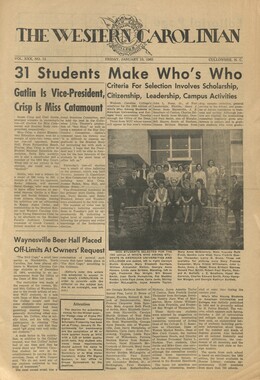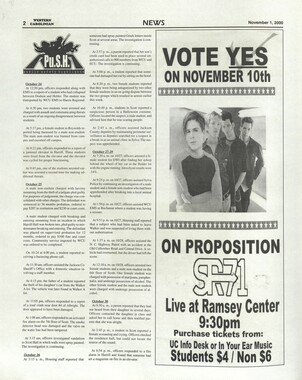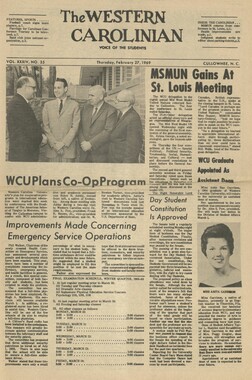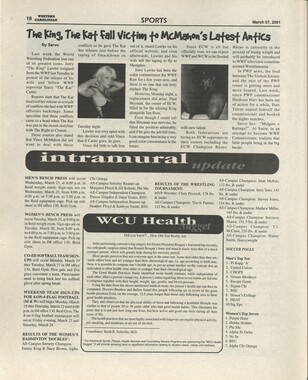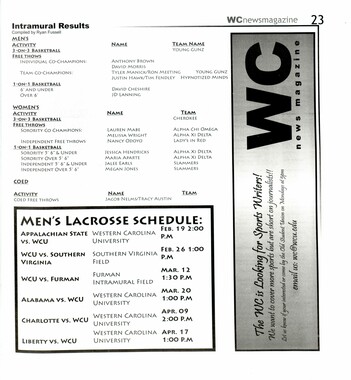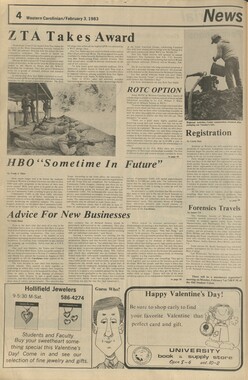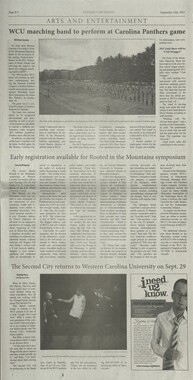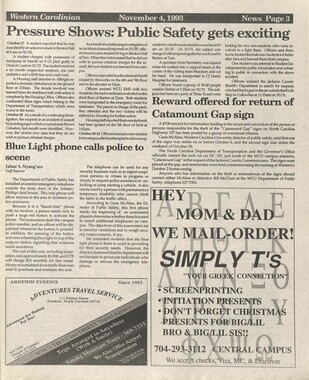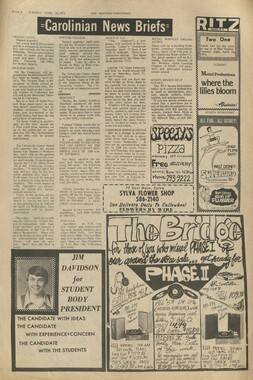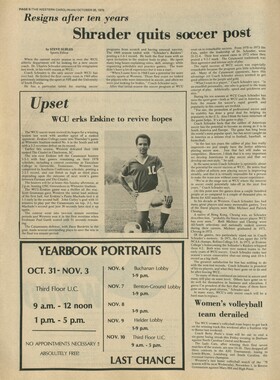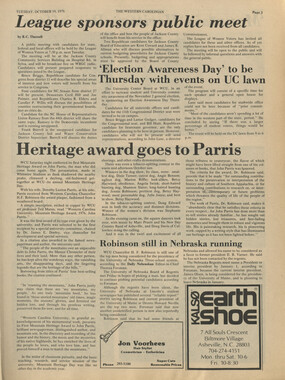Western Carolina University (21)
View all
- Canton Champion Fibre Company (2308)
- Cherokee Traditions (291)
- Civil War in Southern Appalachia (165)
- Craft Revival (1942)
- George Masa Collection (137)
- Great Smoky Mountains - A Park for America (3182)
- Highlights from Western Carolina University (422)
- Horace Kephart (998)
- Journeys Through Jackson (159)
- LGBTQIA+ Archive of Jackson County (90)
- Oral Histories of Western North Carolina (318)
- Picturing Appalachia (6617)
- Stories of Mountain Folk (413)
- Travel Western North Carolina (153)
- Western Carolina University Fine Art Museum Vitreograph Collection (129)
- Western Carolina University Herbarium (92)
- Western Carolina University: Making Memories (738)
- Western Carolina University Publications (2491)
- Western Carolina University Restricted Electronic Theses and Dissertations (146)
- Western North Carolina Regional Maps (71)
- World War II in Southern Appalachia (131)
University of North Carolina Asheville (6)
View all
- Allanstand Cottage Industries (62)
- Appalachian National Park Association (53)
- Bennett, Kelly, 1890-1974 (1463)
- Berry, Walter (76)
- Brasstown Carvers (40)
- Carver, George Washington, 1864?-1943 (26)
- Cathey, Joseph, 1803-1874 (1)
- Champion Fibre Company (233)
- Champion Paper and Fibre Company (297)
- Cherokee Indian Fair Association (16)
- Cherokee Language Program (22)
- Crowe, Amanda (40)
- Edmonston, Thomas Benton, 1842-1907 (7)
- Ensley, A. L. (Abraham Lincoln), 1865-1948 (275)
- Fromer, Irving Rhodes, 1913-1994 (70)
- George Butz (BFS 1907) (46)
- Goodrich, Frances Louisa (120)
- Grant, George Alexander, 1891-1964 (96)
- Heard, Marian Gladys (60)
- Kephart, Calvin, 1883-1969 (15)
- Kephart, Horace, 1862-1931 (313)
- Kephart, Laura, 1862-1954 (91)
- Laney, Gideon Thomas, 1889-1976 (439)
- Masa, George, 1881-1933 (61)
- McElhinney, William Julian, 1896-1953 (44)
- Niggli, Josephina, 1910-1983 (10)
- North Carolina Park Commission (105)
- Osborne, Kezia Stradley (9)
- Owens, Samuel Robert, 1918-1995 (11)
- Penland Weavers and Potters (36)
- Roberts, Vivienne (15)
- Roth, Albert, 1890-1974 (142)
- Schenck, Carl Alwin, 1868-1955 (1)
- Sherrill's Photography Studio (2565)
- Southern Highland Handicraft Guild (127)
- Southern Highlanders, Inc. (71)
- Stalcup, Jesse Bryson (46)
- Stearns, I. K. (213)
- Thompson, James Edward, 1880-1976 (226)
- United States. Indian Arts and Crafts Board (130)
- USFS (683)
- Vance, Zebulon Baird, 1830-1894 (1)
- Weaver, Zebulon, 1872-1948 (58)
- Western Carolina College (230)
- Western Carolina Teachers College (282)
- Western Carolina University (2008)
- Western Carolina University. Mountain Heritage Center (18)
- Whitman, Walt, 1819-1892 (10)
- Wilburn, Hiram Coleman, 1880-1967 (73)
- Williams, Isadora (3)
- Cain, Doreyl Ammons (0)
- Crittenden, Lorraine (0)
- Rhodes, Judy (0)
- Smith, Edward Clark (0)
- Appalachian Region, Southern (3032)
- Asheville (N.C.) (1945)
- Avery County (N.C.) (26)
- Blount County (Tenn.) (200)
- Buncombe County (N.C.) (1680)
- Cherokee County (N.C.) (283)
- Clay County (N.C.) (556)
- Graham County (N.C.) (247)
- Great Smoky Mountains National Park (N.C. and Tenn.) (535)
- Haywood County (N.C.) (3573)
- Henderson County (N.C.) (70)
- Jackson County (N.C.) (4926)
- Knox County (Tenn.) (61)
- Knoxville (Tenn.) (21)
- Lake Santeetlah (N.C.) (14)
- Macon County (N.C.) (421)
- Madison County (N.C.) (216)
- McDowell County (N.C.) (39)
- Mitchell County (N.C.) (135)
- Polk County (N.C.) (35)
- Qualla Boundary (982)
- Rutherford County (N.C.) (78)
- Swain County (N.C.) (2187)
- Transylvania County (N.C.) (270)
- Watauga County (N.C.) (12)
- Waynesville (N.C.) (86)
- Yancey County (N.C.) (72)
- Aerial Photographs (3)
- Aerial Views (60)
- Albums (books) (4)
- Articles (1)
- Artifacts (object Genre) (228)
- Bibliographies (1)
- Biography (general Genre) (2)
- Cards (information Artifacts) (38)
- Clippings (information Artifacts) (193)
- Copybooks (instructional Materials) (3)
- Crafts (art Genres) (622)
- Depictions (visual Works) (21)
- Design Drawings (1)
- Digital Moving Image Formats (2)
- Drawings (visual Works) (185)
- Envelopes (115)
- Exhibitions (events) (1)
- Facsimiles (reproductions) (1)
- Fiction (general Genre) (4)
- Financial Records (12)
- Fliers (printed Matter) (67)
- Glass Plate Negatives (381)
- Guidebooks (2)
- Internegatives (10)
- Interviews (823)
- Land Surveys (102)
- Letters (correspondence) (1070)
- Manuscripts (documents) (618)
- Maps (documents) (177)
- Memorandums (25)
- Minutes (administrative Records) (59)
- Negatives (photographs) (6192)
- Newsletters (1290)
- Newspapers (2)
- Notebooks (8)
- Occupation Currency (1)
- Paintings (visual Works) (1)
- Pen And Ink Drawings (1)
- Periodicals (194)
- Personal Narratives (10)
- Photographs (12977)
- Plans (maps) (1)
- Poetry (6)
- Portraits (4573)
- Postcards (329)
- Programs (documents) (181)
- Publications (documents) (2444)
- Questionnaires (65)
- Relief Prints (26)
- Sayings (literary Genre) (1)
- Scrapbooks (282)
- Sheet Music (2)
- Slides (photographs) (402)
- Songs (musical Compositions) (2)
- Sound Recordings (802)
- Specimens (92)
- Speeches (documents) (18)
- Tintypes (photographs) (8)
- Transcripts (329)
- Text Messages (0)
- A.L. Ensley Collection (275)
- Appalachian Industrial School Records (7)
- Appalachian National Park Association Records (336)
- Axley-Meroney Collection (2)
- Bayard Wootten Photograph Collection (20)
- Bethel Rural Community Organization Collection (7)
- Blumer Collection (5)
- C.W. Slagle Collection (20)
- Canton Area Historical Museum (2110)
- Carlos C. Campbell Collection (564)
- Cataloochee History Project (64)
- Cherokee Studies Collection (4)
- Daisy Dame Photograph Album (5)
- Daniel Boone VI Collection (1)
- Doris Ulmann Photograph Collection (112)
- Elizabeth H. Lasley Collection (1)
- Elizabeth Woolworth Szold Fleharty Collection (4)
- Frank Fry Collection (95)
- George Masa Collection (173)
- Gideon Laney Collection (452)
- Hazel Scarborough Collection (2)
- Hiram C. Wilburn Papers (28)
- Historic Photographs Collection (236)
- Horace Kephart Collection (861)
- Humbard Collection (33)
- Hunter and Weaver Families Collection (1)
- I. D. Blumenthal Collection (4)
- Isadora Williams Collection (4)
- Jesse Bryson Stalcup Collection (47)
- Jim Thompson Collection (224)
- John B. Battle Collection (7)
- John C. Campbell Folk School Records (80)
- John Parris Collection (6)
- Judaculla Rock project (2)
- Kelly Bennett Collection (1482)
- Love Family Papers (11)
- Major Wiley Parris Civil War Letters (3)
- Map Collection (12)
- McFee-Misemer Civil War Letters (34)
- Mountain Heritage Center Collection (4)
- Norburn - Robertson - Thomson Families Collection (44)
- Pauline Hood Collection (7)
- Pre-Guild Collection (2)
- Qualla Arts and Crafts Mutual Collection (12)
- R.A. Romanes Collection (681)
- Rosser H. Taylor Collection (1)
- Samuel Robert Owens Collection (94)
- Sara Madison Collection (144)
- Sherrill Studio Photo Collection (2558)
- Smoky Mountains Hiking Club Collection (616)
- Stories of Mountain Folk - Radio Programs (374)
- The Reporter, Western Carolina University (510)
- Venoy and Elizabeth Reed Collection (16)
- WCU Gender and Sexuality Oral History Project (36)
- WCU Mountain Heritage Center Oral Histories (25)
- WCU Oral History Collection - Mountain People, Mountain Lives (71)
- WCU Students Newspapers Collection (1923)
- Western North Carolina Tomorrow Black Oral History Project (69)
- William Williams Stringfield Collection (2)
- Zebulon Weaver Collection (109)
- African Americans (390)
- Appalachian Trail (35)
- Artisans (521)
- Cherokee art (84)
- Cherokee artists -- North Carolina (10)
- Cherokee language (21)
- Cherokee pottery (101)
- Cherokee women (208)
- Church buildings (190)
- Civilian Conservation Corps (U.S.) (114)
- College student newspapers and periodicals (2012)
- Dams (115)
- Dance (1023)
- Education (222)
- Floods (63)
- Folk music (1015)
- Forced removal, 1813-1903 (2)
- Forest conservation (220)
- Forests and forestry (1198)
- Gender nonconformity (4)
- Great Smoky Mountains National Park (N.C. and Tenn.) (181)
- Hunting (47)
- Landscape photography (25)
- Logging (122)
- Maps (83)
- Mines and mineral resources (9)
- North Carolina -- Maps (18)
- Paper industry (38)
- Postcards (255)
- Pottery (135)
- Railroad trains (72)
- Rural electrification -- North Carolina, Western (3)
- School integration -- Southern States (2)
- Segregation -- North Carolina, Western (5)
- Slavery (5)
- Sports (452)
- Storytelling (243)
- Waterfalls -- Great Smoky Mountains (N.C. and Tenn.) (66)
- Weaving -- Appalachian Region, Southern (280)
- Wood-carving -- Appalachian Region, Southern (328)
- World War, 1939-1945 (174)
Western Carolinian Volume 67 Number 02
Item
Item’s are ‘child’ level descriptions to ‘parent’ objects, (e.g. one page of a whole book).
-
-
wc newsmagazine Fatigue, not thirst, is first sign of dehydration By: Karen White I WCnewsmagazine I Contributing Cool Down and Stay Hydrated What is the best way to cool down in the summer heat? Keeping cool means staying so that your body can perspire. The best way to stay cooLiS•tO;; consume plenty of water. An individual's need for water varies according to body size, activity level, humidity and air temperature, but the average person needs between eight and twelve cups each day, or two to three liters. If you're not getting enough fluids, start increasing your consumption now. Start with water-based fluids, such as juice, milk and water. Keep a cup or a liter bottle on your desk at work. Bring a bottle with you to classes, meetings and in the car on errands. Go easy on caffeinated beverages like sweet tea, coffee and some sodas. Caffeine is a natural diuretic, making you urinate more often, which contributes to dehydration. If you don't like the taste of plain water, try adding a squeeze of lemon or lime juice, or experiment with some of the sugar-free beverages on the market, such as sugar-free Kool-Aid, Crystal Light and Sam's Choice fruit-flavored seltzer water. REMEMBER: Working out in the summer requires extra attention to fluid needs. To keep yourself hydrated, drink: at least 2 cups of water 2-2.5 hours before an activity 2 cups 15 minutes before the activity 1/2 cup every 15 minutes during the activity 2 cups of water or a sports drink after the activity for each pound lost during exercise Be alert to the signs of dehydration. Seek immediate medical attention if you experience: chills, a throbbing pressure in the head, shakiness, nausea, dry skin, disorientation or lack of urination within an hour of exercise. To avoid dehydration, follow the guidelines for fluid intake during exercise, even if you aren't thirsty. Fatigue is the first sign of dehydration- not thirst. For more information, contact Karen White, Health Services Nutritionist at 227-2088 or kawhite@wcu.edu. A person of average body weight requires student livin e an july 2002 How to effectively plan your dream-time By: June Wytock I WCnewsmagazine I Contributing Writer Creative Dreaming Have you ever wondered about the meaning of a perplexing dream? What if you dreamed you were running madly down a narrow corridor; you turn a sharp bend too fast, slip on the slick floor, and fall face first to the ground? What does this mean? How do you make sense out of it? Looking at how dreams have been interpreted historically may help you gain a broader perspective on how dreams can be understood. Dreams have played an important role in history. Socrates had recurring dreams of hearing music. Juseppi Tartini, an Italian violinist, wrote the "Devil's Sonata" entirely from a dream in which he heard the devil playing the violin. Frederick Cucula, a German chemist, developed insight into the molecular structure of benzene through a dream. He dreamed of a snake grasping its tail and translated this symbolic imagery into the concept of the closed carbon ring. Robert Louis Stevenson developed the story characters Dr. Jekyll and Mr. Hyde from his dreams. Dreams may bring pleasure into your life, help you confront danger, and help you become more aware of yourself. How can these rewards be yours? Dream incubation is one way in which you can teach yourself to have the kind of dreams you want. Before going to sleep, choose a dream topic. Clearly formulate a dream plan for what you would like to happen in the dream. Concentrate your attention on this plan just prior to sleeping. Visualize the desired action. As you become drowsy, repeat a few, simple words that describe the events you want to occur. For example, "Tonight I fly," or "I know I'll win." By rehearsing in your mind the theme you want to dream, you can learn how to deliberately invoke relaxed, creative fantasy. Besides the pleasure of experiencing a dream, you may be curious about how to interpret the content. In general, no one can interpret your dreams for you. Only you know what the images mean to you within the context of your life. However, there are several different approaches that can help you figure out the meaning. One is a process developed by Dr. Patricia Garfield, a leading dream researcher. To understand the meaning, write down your dream as soon as possible upon waking. Next, follow this process: -I. 2. 3. 4. 5. 6. Describe the dream in the present tense with as much detail as possible. Reflect on the feelings elicited by the dream. What part was most interesting? Extrapolate the dream to your waking life situation. '(Ihat situation in your waking life gives you a similar feeling? Associate all images in your dream. What part of yourself is being described in each of these images? Meditate on the meaning of the dream. What waking situations elicit similar feelings and actions? Summarize the action of the dream in a message. Summarizing the message can help you learn from the dream and use it in your life. For example, let's return to the dream given at the beginning of this article. A CD cups of water each day* *Based on avera e bod wei ht, eve ne is different. frantic, pressured feeling is the most predominant part of the dream. If this feeling is particularly strong, it may linger even after waking. Reflecting on similar waking life situations, the dreamer may recall feeling that same harried, rushed sensation going to class. Trying to get everything done on time, elicits the same feeling as in the dream. An action message that could summarize the meaning in this dream might be, "Slow down. Don't rush. You're going too fast." If you are interested in exploring more about dreams, you can attend an evening presentation on "Dreams: What Do They Mean?" on Thursday, July 18, 7:30 — 8:30 P.M. at the 2nd Floor Classroom, Leatherwood Hall. You do not have to have a dream to share in order to attend. To find out more about free, personal counseling on campus, call 227-7469 (Counseling & Psychological Services Center). The Counseling Center is located on the first floor, east wing of Scott Hall. Services are free of charge to students. Hours: 8 AM — 5 PM, Monday — Friday. (June Wytock is a Staff Member of Counseling & Psychological Services.) For More Student Health Information Go ONLINE!
Object
Object’s are ‘parent’ level descriptions to ‘children’ items, (e.g. a book with pages).
-
The Western Carolinian is Western Carolina University's student-run newspaper. The paper was published as the Cullowhee Yodel from 1924 to 1931 before changing its name to The Western Carolinian in 1933.
-
